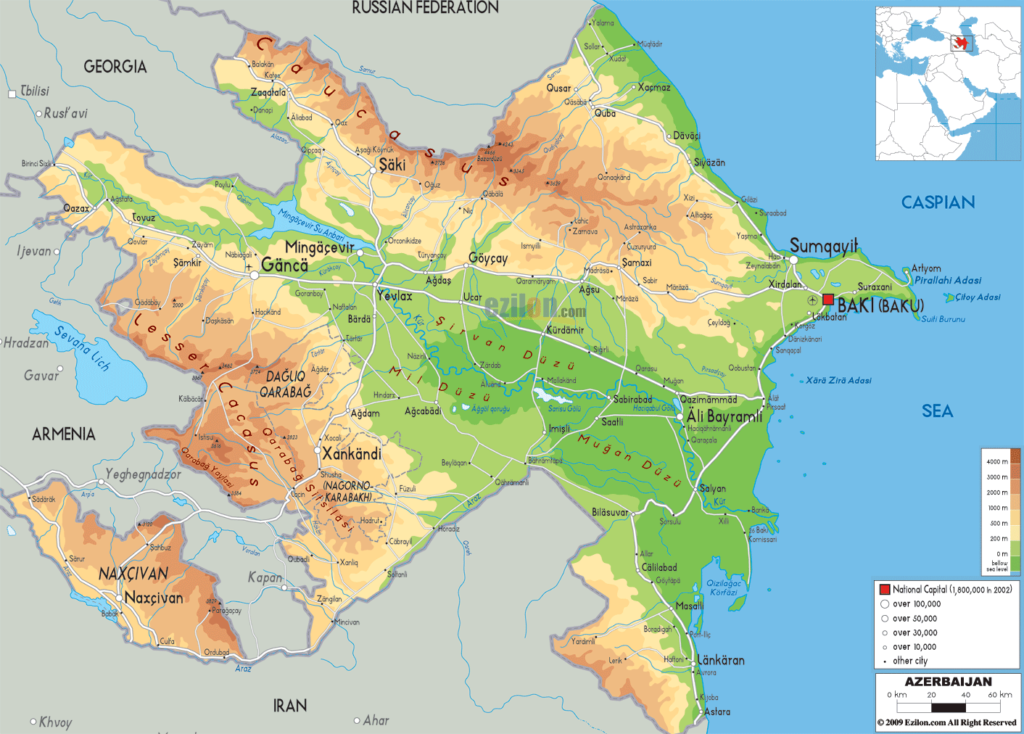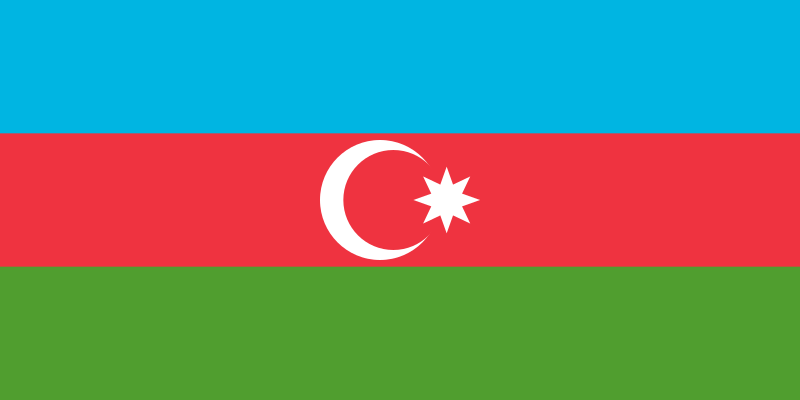My trip to Turkey and the Caucasus includes five nights in Azerbaijan: four in Baku, the capital city, and one in the mountain town of Sheki, in the northwest of the country. The basic itinerary is set, but I have a lot of day-tour options I still need to decide on.
I am using the same day numbering here as I used in my last posts. I arrive in Azerbaijan on Day 15 of my trip, so I’ll start from there.
But first, a little about Azerbaijan

Azerbaijan is a relatively new country, as are all the countries of the South Caucasus. The region was only divided into the three countries that exist today in 1918. Azerbaijan was a region of Iran (Persia) until the middle of the nineteenth century. After the Russo-Persian War of 1826–28, Russia took possession of what is now Azerbaijan. After the Russian empire fell, the regions of the South Caucasus briefly formed the Transcaucasian Democratic Federative Republic, but after a month, the three countries declared independence.
Azerbaijan formed the first parliamentarian republic in the Muslim world in May 1918. It was also the first Muslim nation to grant men and women equal political rights.
In 1920 Vladimir Lenin, declaring that Soviet Russia could not survive without Baku’s oil. The Red Army attacked Azerbaijan and the country was quickly subsumed as one of the Soviet Socialist Republics.
When the Soviet Union fell, Azerbaijan declared independence once again, on October 18, 1991. Unfortunately, the country has suffered from corruption and tainted elections. The current president, Ilham Aliyev, has been in power since 2003. Journalists, lawyers, and activists critical of the government have been arrested and jailed. Freedom House gives them a ranking of 9 out of 100 in Global Freedom Status. (By comparison, Cuba’s ranking is 12, Russia’s is 19, and China’s is also 9.)
Today Azerbaijan has a population just over 10 million; over 90% of the population are ethnic Azerbaijani. The religious makeup is predominantly Shia Muslim, though Azerbaijan is considered the most secular of Muslim countries, and there is no officially established religion.
Baku
On the shore of the Caspian Sea, Baku (in Azerbaijani: Bakı) is the capital and largest city, with a population of 2.3 million and over 5 million in the metro area. At 28 meters (92 feet) below sea level, it is the lowest-lying national capital in the world and the largest city in the world below sea level.
Archaeological evidence suggests a Roman settlement at Baku in the first century C.E., but beyond that, there is no historical record of Baku until the tenth century. In 1191 it became the capital city of the Shirvanshahs, the royal family who ruled the region. Between the 12th and 14th centuries they built a fortification. But in the 16th century the Safavids laid siege to Baku and captured it, ending the rule of the Shirvanshahs.
In 1723, after another siege, Russia gained control of Baku, but just twelve years later, the Persians forced the Russians out. In the early nineteenth century, two Russo-Persian Wars (1804–13 and 1826–28) brought Baku and all of the South Caucasus under Russian control.
Interest in Baku has for centuries been driven by oil. In the 16th century residents burned oil in their houses. By the 1630s there were thirty oil fields in Baku. Russian interest in the area has long been driven by the wealth of petroleum in and around Baku.
In the thirty years since the fall of the Soviet Union, oil has provided Baku with an economic stimulus, leading to a tremendous building boom. While there is much to see from earlier times, the city is also filled with striking examples of modern architecture (as I previously described).
So here’s my plan for my time in Baku:
Day 15
My flight from Istanbul is scheduled to depart at 5:15 pm and arrive at Heydar Aliyev International Airport at 8:55 pm. So I don’t think I will do much, if anything, this first day. A driver should be waiting for me to take me to the Two Seasons Boutique Hotel, in the heart of Baku’s old town.
Day 16
JayWay Travel provides a number of tours built into my itinerary, but I can swap them around as much as I want until about a month before the trip.
My first full day in Baku, they’ve scheduled a four-hour driving and walking private city tour. My guide will pick me up at the hotel, and we start by exploring the Old Town. We visit the Palace of the Shirvanshahs, the biggest monument in the center of the city and the 12th-century Maiden Tower. Next is a short tour through Baku Boulevard, a promenade along the seafront. Then we Fountain Square, constructed during the Soviet rule of Azerbaijan. The tour concludes at Highland Park, with panoramic views of the city.
As best I can tell, all of these sights are within easy walking distance of my hotel. And there is a funicular leading up to Highland Park. There is a shorter Old Town walking tour, so I might consider doing that and then visiting the other sights on my own.
At the end of the tour, I will have the rest of the day free to explore on my own.
Day 17
Today JayWay has scheduled a tour they call “Highlights of Baku’s Surroundings.” This is a private tour lasting 8–9 hours.
Once again my guide will pick me up at the hotel in the morning. We’ll travel to the Gobustan National Historical-Artistic Preserve, about 70 km from Baku to see prehistoric rock drawings. Next we go to the famous Mud Volcanoes. Over a thousand mud volcanoes exist in the world, and some 400 of them are in the coastal area of Azerbaijan. The third stop is the Bibi-Heybat Mosque. Built in the 1990s, it’s a recreation of a 13th-century mosque that was completely destroyed by the Bolsheviks in 1936.
Back in Baku we go for lunch at an authentic Azerbaijani restaurant. Then there’s a second part of the tour. It starts at the Ateshgah Temple of fire worshippers, on the Apsheron peninsula about 30 km from Baku. The last stop is Yanar Dag, a natural gas flame in the hills. According to JayWay, it’s one of Azerbaijan’s most popular tourist sights.

Jesper Ahlin Marceta, CC BY-SA 4.0 https://creativecommons.org/licenses/by-sa/4.0, via Wikimedia Commons

According to Wikipedia, the flames shoot up ten feet into the air.
Diego Delso, CC BY-SA 4.0 https://creativecommons.org/licenses/by-sa/4.0, via Wikimedia Commons
Day 18
Today is a free day in Baku. JayWay offers a number of optional tours for this day, or I can just enjoy the free time to explore Baku on my own.
Here are some of the tours options available.
Private Food Tour including tasting at Yashil Market
This is a three-hour tour of Yaşıl Bazar, with a chance to learn about and sample some classic local dishes, sweets, and tea. I could do this in the afternoon of Day 16.
Old Town Private Walking Tour
As best I can tell from the description, this is a duplicate of the walking part of the first day tour. I suppose I could opt for it on Day 16 if I want a shorter tour and decide to visit the sights outside the Old Town on my own.
Khinalig Private Day Trip
This full-day excursion starts in the Khizi region and its mountainous landscape. On the road we pass through Sumgait, the second biggest city in Azerbaijan. Then we continue to the Guba region. We visit the carpet factory, the Jewish Quarter, and the Gechresh Forest. Next we go to Xınalıq (or Khinaliq). JayWay says this is “the most beautiful and interesting village of Azerbaijan. It’s located in the Lower Caucasus mountains. By some definitions Xınalıq is Europe’s highest village. The whole scene is often magically wrapped in spooky clouds that part to reveal 360-degree views of the surrounding Caucasus.”

azerbaijan08, CC BY-SA 1.0 https://creativecommons.org/licenses/by-sa/1.0, via Wikimedia Commons

Emin Bashirov, CC BY-SA 3.0 https://creativecommons.org/licenses/by-sa/3.0, via Wikimedia Commons

Toni Wöhrl, CC BY-SA 4.0 https://creativecommons.org/licenses/by-sa/4.0, via Wikimedia Commons
I’m considering swapping this trip for the “Highlights of Baku’s Surroundings” tour scheduled on Day 17. If I don’t do that, I am pretty sure I will want to do this tour on Day 18. I need to do some more research and talk to my JayWay Travel Advisor before I make up my mind.
Baku by Night Private Tour
This three-hour tour is a chance to appreciate Baku when it is all lit up at night. The majority of the historical buildings in the city center are targeted with upward flood lights. Everything from Maiden’s Tower to the Old City walls to museums to government buildings all get the electric lighting treatments. I could probably do this tour any of the three nights I’m here.
Museums in Baku
In addition to tours, Baku has a few recommended museums:
- Azerbaijani National Carpet Museum
- National Museum of History
- Heydar Aliyev Center
- National Museum of Art
- Museum of Miniature Books
Day 19
Today I depart Baku and head for Sheki. I’ll have a private driver. Along the way we’ll stop at Diri Baba Mausoleum and Juma Mosque of Shamakhi.

Diego Delso, CC BY-SA 4.0 https://creativecommons.org/licenses/by-sa/4.0, via Wikimedia Commons
Sheki
Sheki (in Azerbaijani: Şəki) is a city of about 68,000 residents nestled among the Greater Caucasus mountains. The historic center of Sheki is a UNESCO World Heritage site.
Sheki was founded in the 8th century B.C.E. In the Middle Ages it became a trading center on the Silk Road. Of the five caravanserai that existed, two remain, and many other old buildings have survived.
Day 19
Sheki is about 4 to 4 1/2 hours from Baku. If we get an early start, even with stops I hope to get there in the early afternoon. JayWay has scheduled a two-hour walking tour when I arrive. After that, I have the rest of the day free.

Day 20
Today I’m on the move again, and I will say good-by to Azerbaijan and hello to Georgia.
Stay tuned for my upcoming post about the Georgia section of my trip.








Leave a Reply